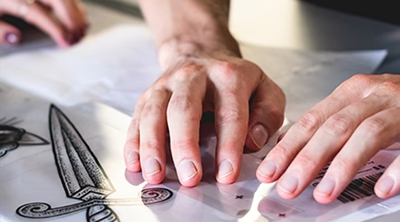Heat Transfer vs Screen Printing for T-Shirts
Screen printing and heat press is a printing technique that involves transferring ink onto fabric or other materials using heat and pressure. It is a popular method for creating high-quality and long-lasting prints on t-shirts, hats, bags, and more. Screen printing heat press is commonly used by businesses and individuals for custom printing and branding.
This blog offers a great insight on screen printing & heat press techniques:
Understanding the Screen-Printing Process
The screen-printing process places thick ink on a mesh screen and then applies it over a stencil, producing a raised design on T-shirts with the appropriate printing designs. Silk screening is another name for this procedure.
Screen printing lacks printing multiple colors directly onto the fabric, as can be possible with digital garment printing (DTG); however, screen printing delivers classy and raised print that's capable of lasting long when compared with DTG.
Heat Press Transfer Process
A heat transfer process creates the printing with heat transfer vinyl or HTV, and this product comes in different colors and textures; it always comes with an adhesive coating on the back. When the heat press comes into contact with an adhesive layer, it permanently adheres the vinyl to the fabric.
Nowadays, more artists use computer-controlled programs to create vinyl transfer cutouts, and one example is Cricut's design. Following that, an electronic cutting machine is employed to slice out the desired shape; it can be an image, a lettered logo, or a funny saying. By using the HTV cut out
What Sets Heat Press Transfer Apart from Screen Printing?
Now after being aware of the methods of printing by heat press transfer and screen printing, we have an idea with about two types of printed patterns on our T-shirts. Let's know that! Here, we will discuss these processes on their differentiations; the key points will be cost efficiency, durability, and quality.
Durability
Your mind might be struck to know which printing lasts longer. Well, screen printing is considered to be more durable. Heat press transfers, on the other hand, have a respectably lengthy lifespan and will continue to look good for a considerable amount of time until eventually cracking and fading.
Application
In terms of application, using a heat press to apply an HTV pattern is more convenient as compared to designing print-by-screen printing. Of course, this varies greatly depending on the type of transfer design and the complexity of the print. But screen printing produces a design that is a bit higher quality, and using vinyl is the more straightforward choice.
Cost-Efficient
When trying to know which method will be cost saving, the answer is screen printing since screen printing uses a screen that can be used multiple times to scale a more significant number of T-shirts at a lower cost than heat press transfer.
It can also be considered in different order styles; if it is the order of printing one or two T-shirts, the heat press transfer will be more cost friendly. Otherwise, you can make a real deal using screen printing when the order states a bulk quantity.
Quality
There is a better case to be made for screen prints' superior quality to heat transfer designs, albeit not everyone agrees. This is partially due to the fact that layering colors is simpler in screen printing than in HTV. Additionally, screen printing frequently results in more vibrant colors than heat transfer.
Additionally, light-colored shirts are the best for displaying heat transfer designs. Depending on the color of ink you use, you can screen print on both light and dark clothes.
Final judgment: Which is Better, Between Heat Press and Screen Printing?
The screen-printing process will be desirable to give a bright and prolonged appeal.
Using a heat press transfer for simpler, less expensive designs or flexible orders. With this method, there are hardly any setup or material costs, making it simple to sell modest quantities without suffering a financial loss.
Finally, screen printing should be used for major projects or requests in quantity. With this technique, T-shirts become more affordable the more you produce!


.jfif)
Comments
Post a Comment